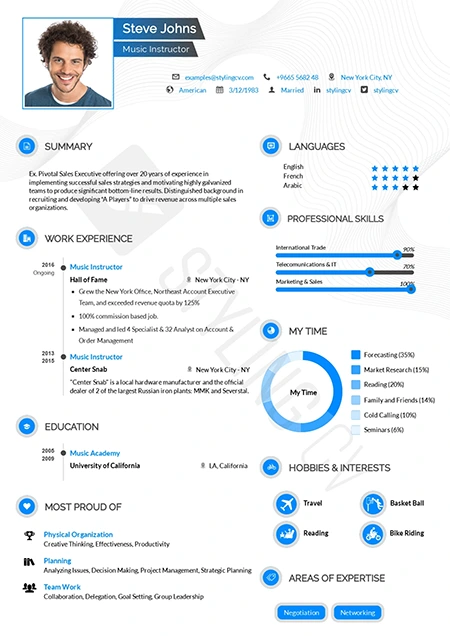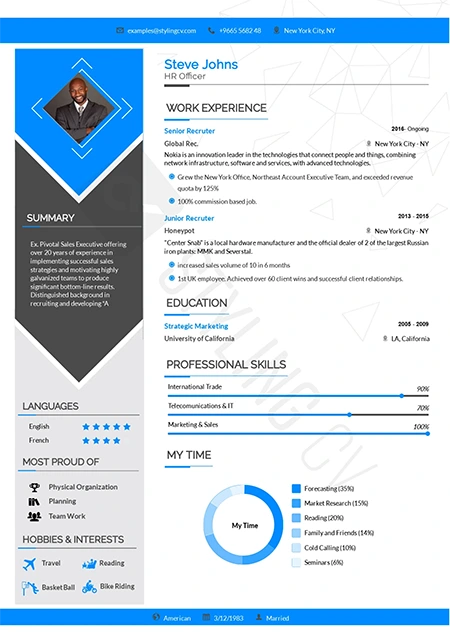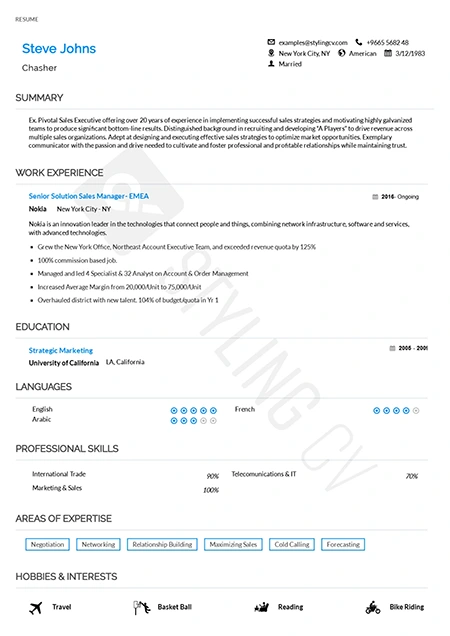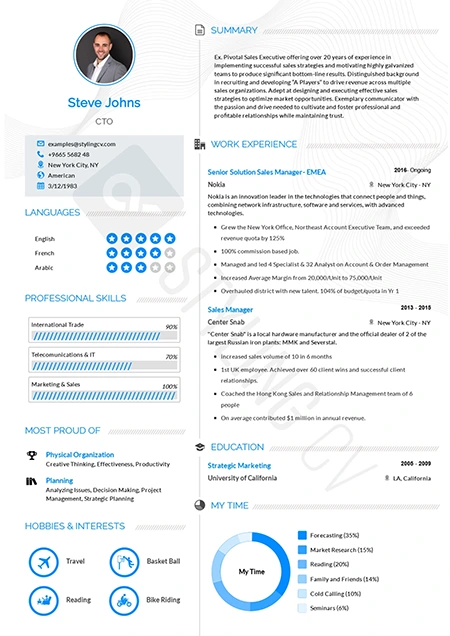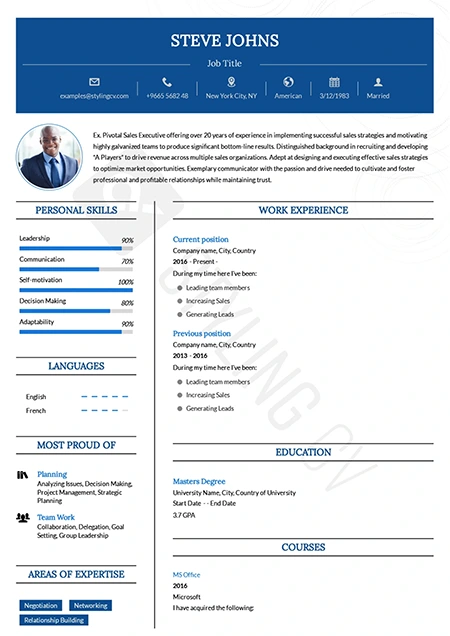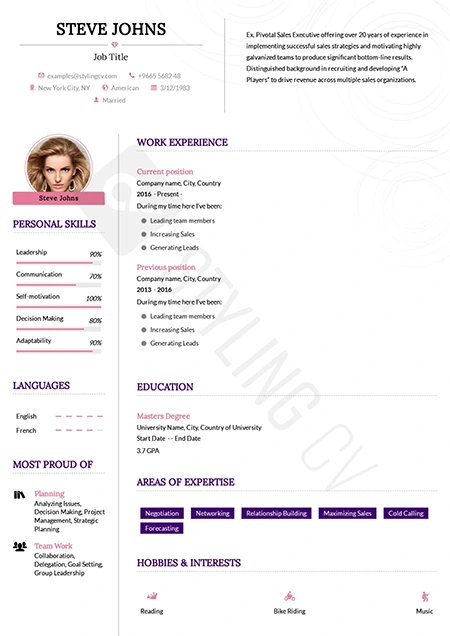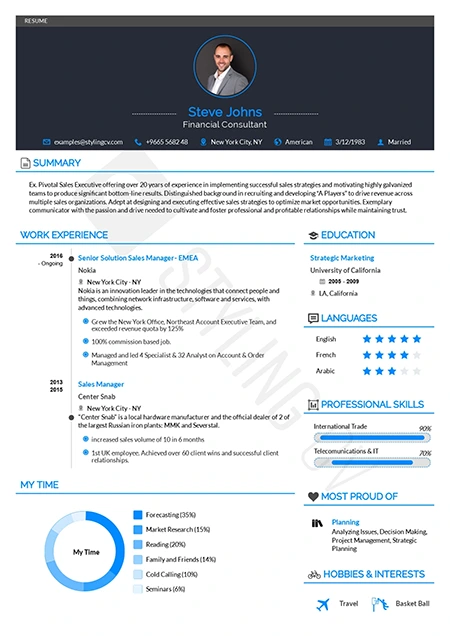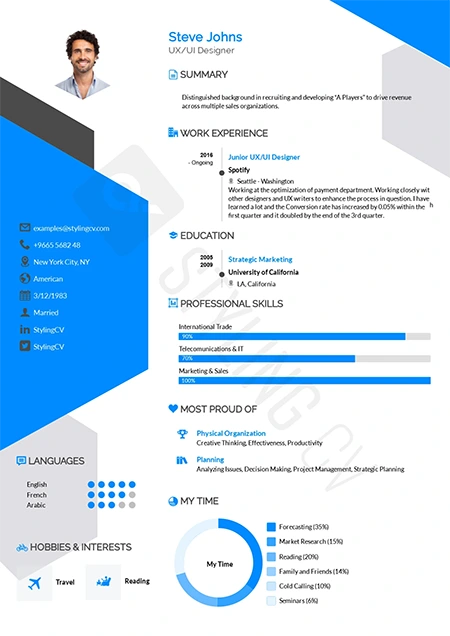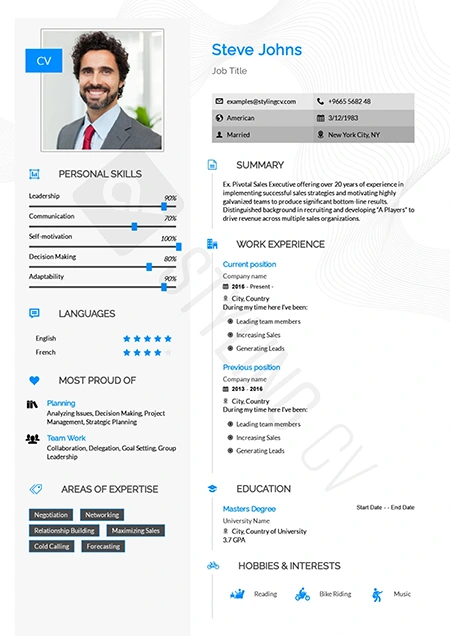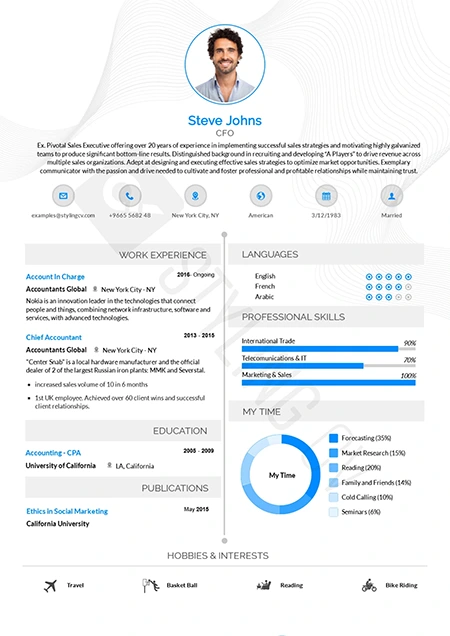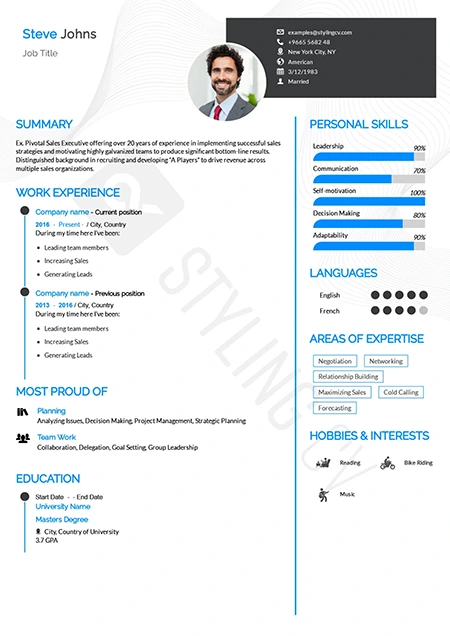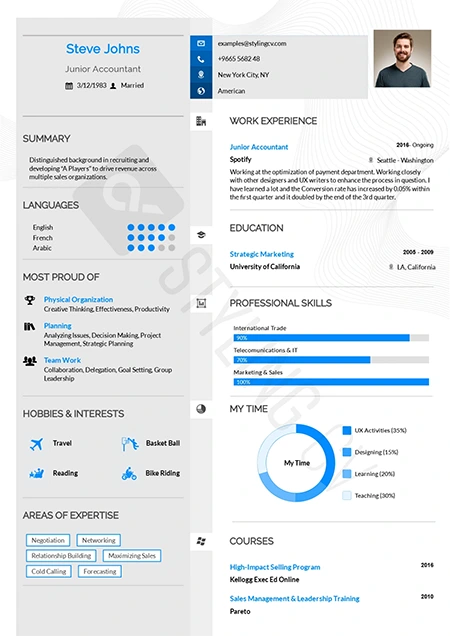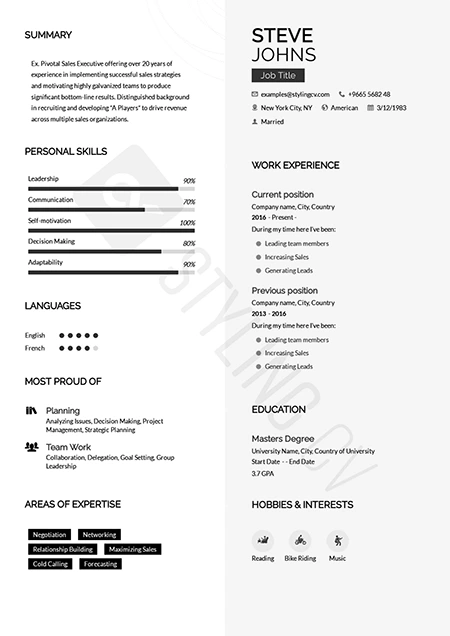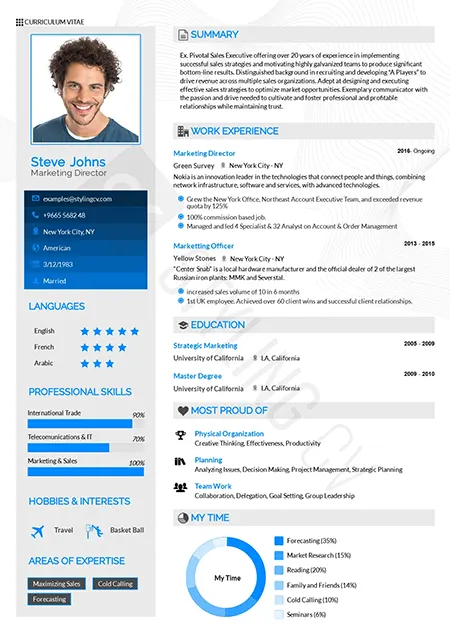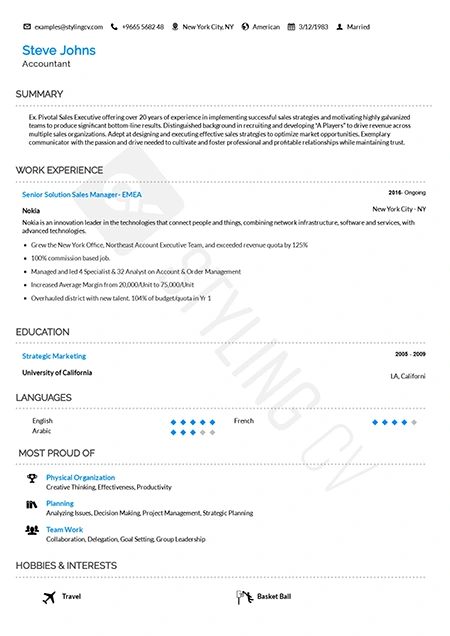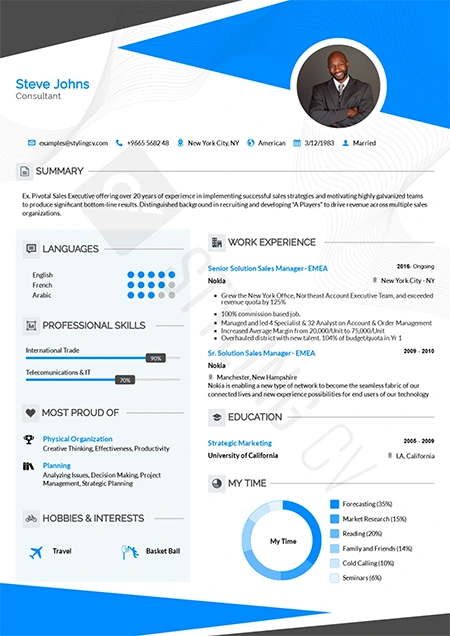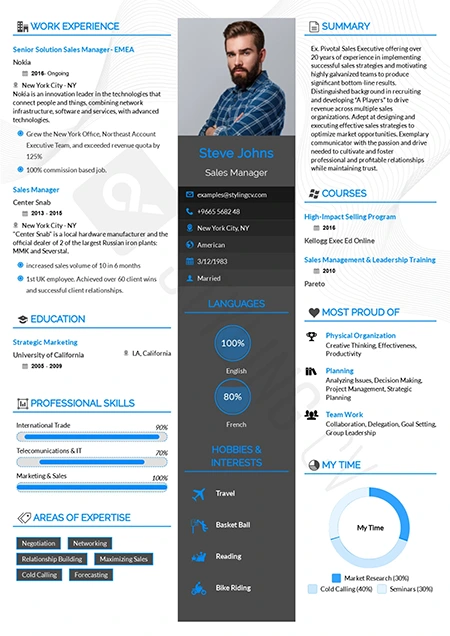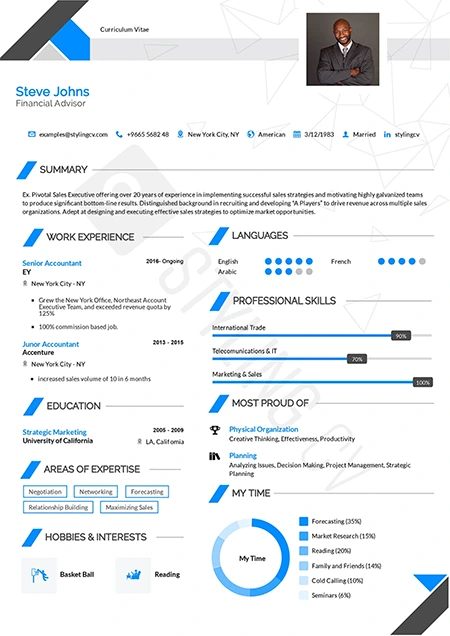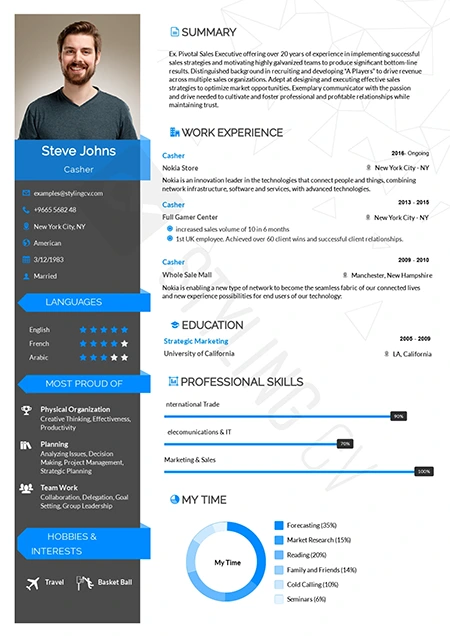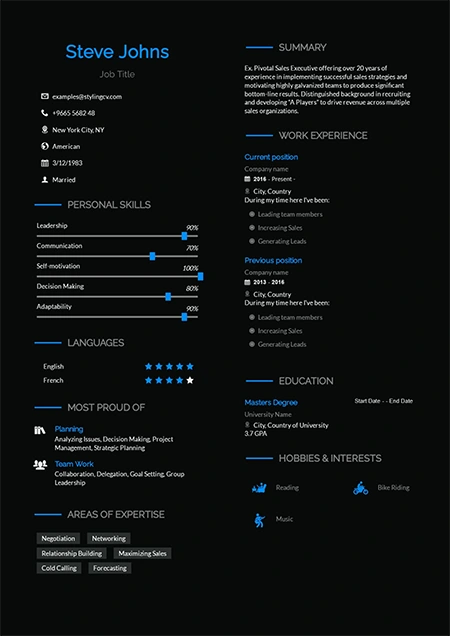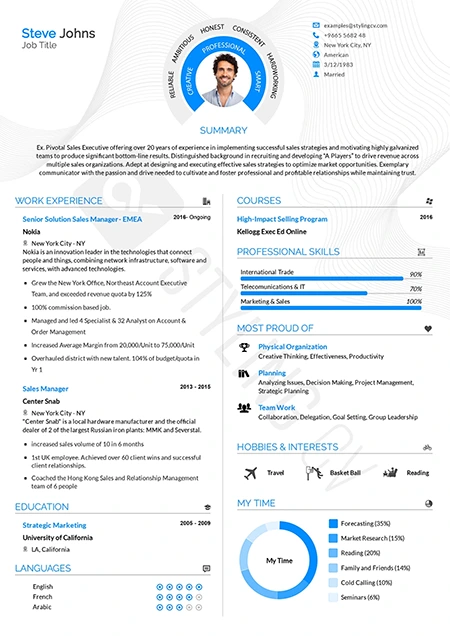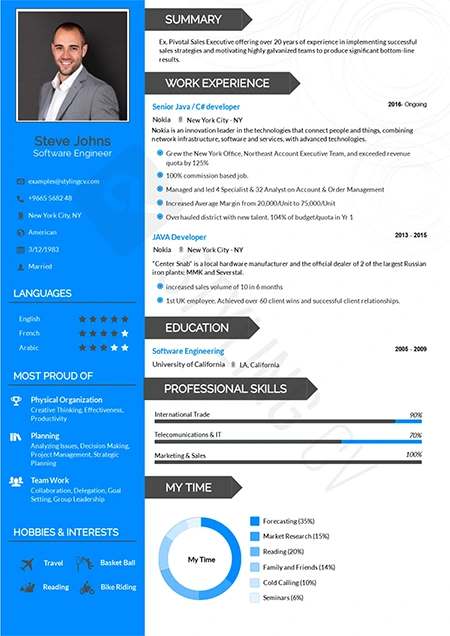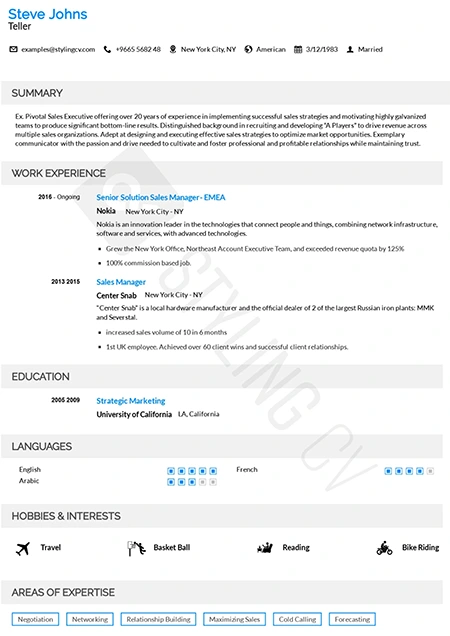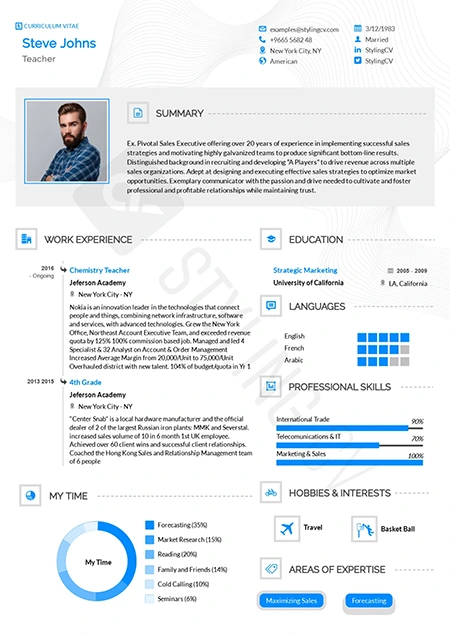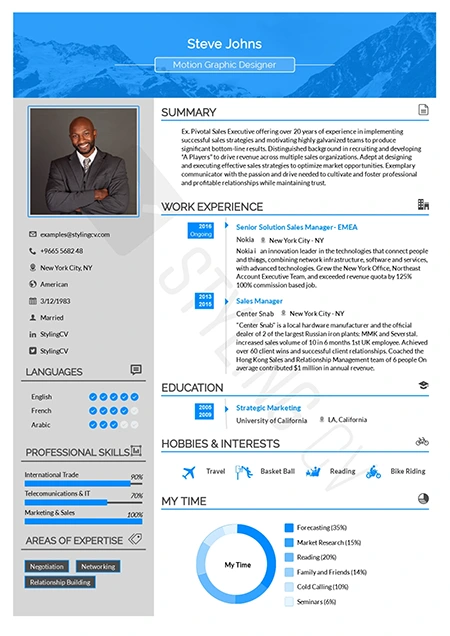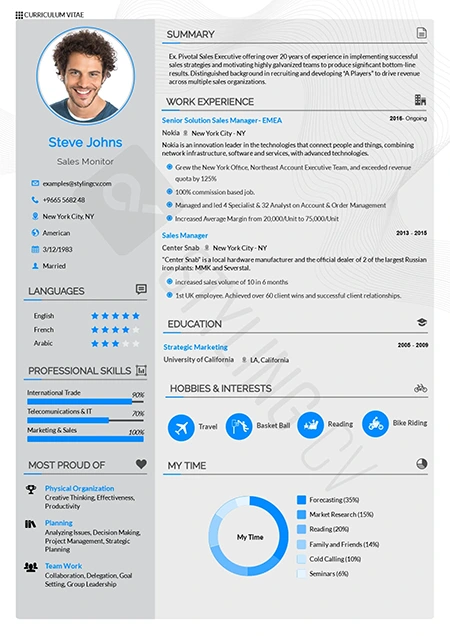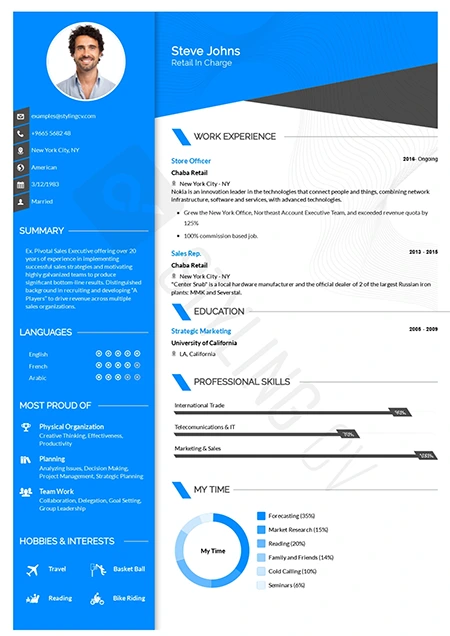we provide you 33+ CV templates
Unraveling the Ideal CV Template: Integrating Work History, Work Experience, and More
Crafting a powerful curriculum vitae (CV) can be a challenging task, especially if you’re unsure of what it should encompass. The right CV template can be the key to not only highlighting your work history and experience but also standing out from the rest of the applicants. In this comprehensive guide, we delve into the structure of an effective CV, the nuances of writing one, and the role of a cover letter in complementing your CV.
The Fundamentals of a CV Template
A Curriculum Vitae, Latin for “course of life”, is a detailed document highlighting your professional and academic history. Unlike a resume, which is typically concise and tailored to a specific job, a CV is more comprehensive, including publications, presentations, and other relevant details.
An ideal CV template, at its core, contains several key sections:
- Contact Information: This includes your full name, professional title, email address, phone number, and possibly a LinkedIn profile or personal website.
- Personal Profile: This is a brief, high-level overview of your background, skills, and career objectives.
- Work History: Here, you’ll detail your employment journey, outlining your roles, responsibilities, key achievements, and the companies or organizations you worked for.
- Education: This section lists your academic credentials, including the institutions you attended, the degrees you earned, and the dates of your studies.
- Skills: It’s crucial to highlight both soft and hard skills that you possess, relevant to the job you are applying for.
- Certifications and Achievements: Mention any additional certifications, awards, or recognitions that can boost your profile.
- References: These could be professional or academic, and must be provided with their consent.
Importance of Work History and Experience
Work history and work experience are key pillars in writing a CV. Employers often place a significant emphasis on these sections as they provide a glimpse into your potential as an employee. Your work history should be detailed chronologically, starting with your most recent position. For each role, specify the job title, employer, dates of employment, and your core responsibilities and achievements.
While listing your work experience, it’s essential to focus on what you achieved during your tenure and the skills you developed or honed. Avoid generic statements and make your accomplishments measurable where possible, demonstrating your value through concrete examples.
Juxtaposing CV and Resume Templates
While ‘CV’ and ‘resume’ are often used interchangeably, they differ in content, length, and purpose. A resume template is typically shorter and more concise, focusing primarily on relevant experience and skills tailored to a specific job application. On the other hand, a CV template offers a more detailed overview of your professional and academic life, ideally suited for positions in academia, research, or those requiring comprehensive career information.
The Power of a Compelling Cover Letter
A cover letter should never be an afterthought. Instead, it should serve as a personalized introduction, a platform where you can convey why you’re the perfect candidate for the job. It allows you to explain in your own words how your skills, experiences, and achievements align with the company’s needs. Remember, the cover letter isn’t a repetition of your CV; it’s your opportunity to tell a story, showcase your personality, and build a connection with the hiring manager.
Final Thoughts on CV Writing
When writing a CV, it’s essential to tailor it to the job you’re applying for. Take the time to research the company, understand the role, and align your experience, skills, and achievements accordingly. Keep your CV concise, clear, and professional, avoiding unnecessary jargon or long-winded sentences. Prioritize quality over quantity, ensuring each word holds value and relevance to the job application.
Formatting and Presentation
The visual aspect of your CV can be as influential as its content. In today’s digital age, a well-formatted, easy-to-read CV can make a significant difference. Keep the layout clean and structured, with plenty of white space and clearly defined sections. Use a professional font and maintain consistency throughout your document. Bullet points can aid readability, and subtle color accents can make your CV stand out without being overwhelming.
A Glance at Digital CVs
As the business world increasingly embraces digital solutions, digital CVs are becoming more prevalent. These offer a more interactive experience, enabling you to incorporate elements like links to portfolios, presentations, publications, or even video introductions. Ensure your CV is compatible with both print and digital formats to cater to different employer preferences.
Proofreading Your CV
Proofreading is a crucial yet often overlooked step in writing a CV. A single typo or grammatical error can undermine your professionalism and credibility. Use spell-check tools, but don’t rely solely on them. Read your CV out loud, have a peer review it, or even consider professional proofreading services. This diligence helps ensure your CV is polished and error-free.
Key Takeaways
A comprehensive and well-structured CV template, incorporating key sections like work history and work experience, can be a powerful tool in your job search. Coupled with a compelling cover letter, it presents you as a well-rounded, detail-oriented candidate. Remember, your CV is more than a list of your professional experiences; it’s a representation of your dedication, skills, and potential.
In essence, writing a CV is an exercise in personal branding. Each element should work harmoniously to project the best version of your professional self. Whether you’re a seasoned professional or just starting on your career path, investing time and effort into your CV can open the doors to exciting opportunities. Harness the power of the ideal CV template, and make your job application stand out from the rest.
Catch Your Template Now!
Start with our 100s of widgets and color options to start your Resume
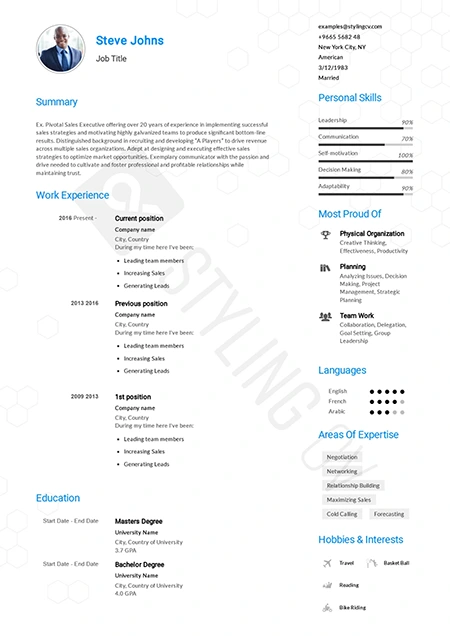 Select
Select A minimal design for teachers and educators. Clear infor-ghraphics that showcases your skills with clarity in your resume.
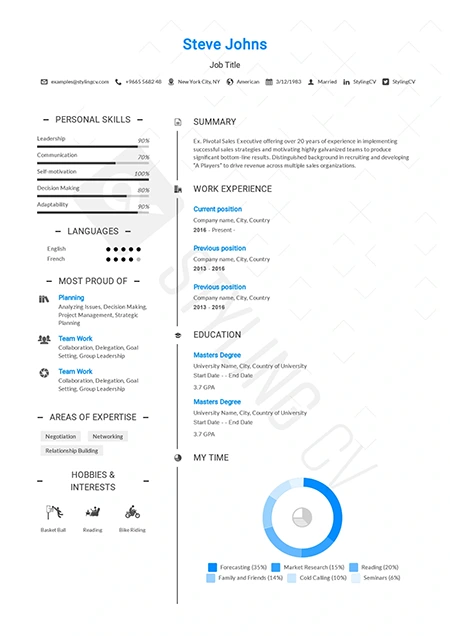 Select
Select The pointy header with it’s strong colors are a dominant show for your resume. Your skills have a great place on the left in this resume template.
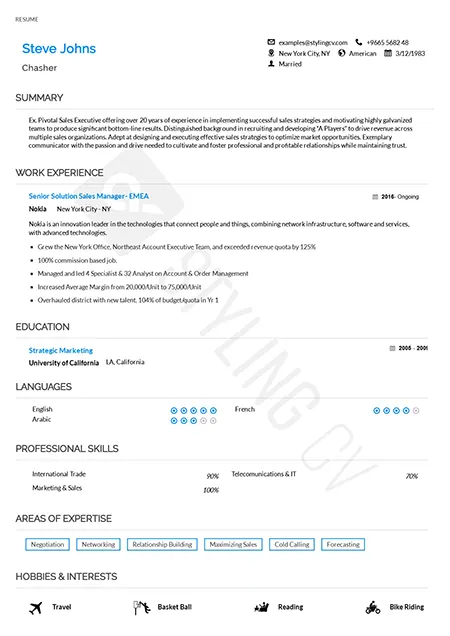 Select
Select
Learnt languages, professional and soft skills and hobbies have a place on the left. While your educational and professional skills are on the right in this resume template
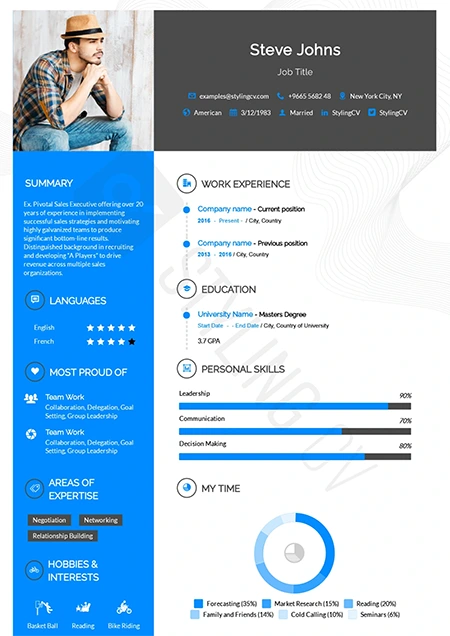 Select
Select
A bright and colorful resume template. Be seen by the recruiters instantly with a diverse list of colors
catics-en
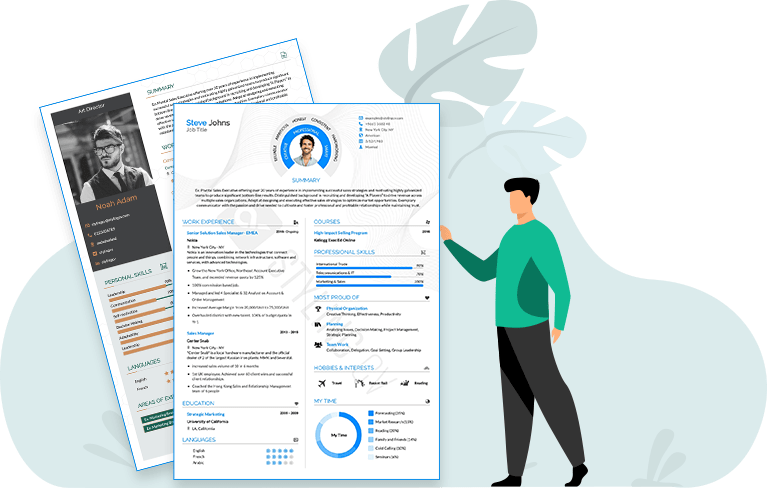

What is a CV?
A CV is a brief summary of you to shine showing professional and personal experiences, skills, and academic education.
a well written CV including a cover letter could be the difference between getting an interview and not being considered for the role. Read more about how to write a CV.

How to write a CV for your first job?
The process of writing a CV can seem very intimidating to you. After all, most of the CV examples you see on websites are 80% related to work experience. So, what can be included in your CV if you do not have any previous experience?
Well, here’s some good news. If you are applying for your first job, no one expects you to have any previous work experience.
Instead, you should focus on what you have:
- Education
- Projects
- Volunteer experience
- Hobbies and interests.
About the Complete Guide How to Create a CV Without Work Experience

What do you write in a CV?
during intense competition in the market, with major and fundamental changes, writing a professional CV became a key factor in your success in getting the job of your dreams
Here is a few essential things you should aim to cover in your CV:
- Contact information
- Summary of CV and goal
- Previous experience
- Academic education
If you want to personalize your CV, you can also include the following sections:
- Projects
- Volunteer experience
- Hobbies and interests
For more information on how to put these sections into a CV, see our article on What to Put in a CV.

How to Coordinate the format a CV?
There are 3 typical CV formats:
- Reverse time format
- Skills-based job coordination format
- The comprehensive coordination combines the two previous formats
In 99% of the cases, you will want to use the reverse time format. CV mainly focuses on your work experiences, and is written in reverse time order (i.e. experiences are ordered from newest to oldest)
Unless you want to create a CV with a skill-based job format, we recommend sticking with the reverse time format.
If you want to know more about CV formats, check out our comparison guide.
Always make your CV matches the job you want
Do you want to send 50 CVs to get only two job interviews? OR do you want to send eight CVs and get three or four job interviews?
If you choose the second option, it is easy. Always make sure to write your CV to suit the job title of the job you want to apply to.

How long should a CV be?
How many pages should a CV be?
The most common CV question in the world: “How long should your CV be?”
answer: one page. If you have a lot of work experience (10 years +), sometimes it makes sense to make it a maximum of two pages if everything you mentioned is relevant to the position you are applying for.
Note: All of our templates are one-page CV. when you add more experiences, a second page will be added automatically, so you will not have problems adhering to the one-page limit!

How to write a CV summary?
attract readers by adding a summary at the top of the CV. Think of it as an introduction to your CV. You should highlight in two to four sentences your skills, experience and suitability for the job you are applying for.
make your personal summary shines while using this perfect formula:
[Job title] with X + years of work experience in [Job Responsibility]. In X of years, I had [the most important two or three] accomplishments. I find myself a good fit for [title] in [company name].
To learn more about how to create a professional CV summary, check out our guide.
On the other hand, if you are a student or do not have much work experience, read more about how to create a student CV.

How to write work experiences in a CV
How to write work experiences in a CV
practical experiences on a CV One of the things that is easy to learn and hard to master
- Job title
- The name of the company / institution / employer
- Achievements or responsibilities
- Date of work
Now, if you want to write an outstanding work experience, you should focus on measurable accomplishments
Use this formula: I solved the problem (x) by doing (y) to get the result (z).
Example: Negotiate a plan with suppliers to reduce office expenses by $ 5,000 annually.
Show your accomplishments through numbers. Do not provide sensitive information.
increased sales by 20% in 12 months.
This shows the employer that you are not just a random candidate, you are an excellent person!
To learn more about how to write accomplishments in your work experience (and get the job) see our article.

How to list skills in a CV?
Simply create a “Skills” section on your CV template, list your most important skills.
We usually recommend writing technical and personal skills.
Not sure which skills to include on your CV? Check out the 50 best skills to enrich your CV.

How to create a cover letter for your CV?
Every job application requires a cover letter (in addition to your CV). Here are some tips on how to do it right:
- Personalize your cover letter to the employer. The more personal, the more likely it is that your experiences will be liked
- Identify your general experiences (work experience, job title, etc.) and list the 2 to 3 most important accomplishments to demonstrate your skills
If you really want to stand out, create a cover letter that matches your CV template. To do this, you can use one of our cover letters.

What is the best CV template?
There is no such thing as a “best CV template” – every employee / employer has their own characteristics. We recommend that you research about the company you are applying to
For example, if you are applying for a job at a bank, you may want a more professional CV template. On the other hand, if you want a job at a startup company where they value innovation the most, you should stick with this creative CV template.
Finally, if you are still not sure which type of template is right for the job you are applying for, you can use one of the professional CV templates that will fit that job.
CV Resources
A CV is a brief summary of personal and professional experiences, skills, and education history. Its main purpose isn’t just to show off your best self but also to keep you employed by showing what sets you apart from other applicants who may be vying for the same position!
You know how to make a CV, but are you applying the right strategies? We have all heard of “good” CVs and bad ones. But what about the great ones-the best way for job seekers who want their chances at success in finding work increased by twofold or more! Check out this guide on creating an awesome CV that really gives recruiters something worth checking off their list when reviewing applications.
How to Write a CV for Your First Job?
The process of writing a CV might seem super scary to you. After all, most CVs are 80% about work experience and 20% summary of other accomplishments which can make it hard for those without any professional achievements or training in this area at all!
I know it’s not easy especially when there’s such an emphasis placed on getting your foot into that door as soon as possible but don’t worry -we’ve got some ideas on how to get started with making sure yours stands out from others…
According to many people, including me when I was just starting out in the industry and applying for jobs or internships myself- no one expects you have ANY work experience. The idea is that an employer will give spots based on ambition alone so doing some research beforehand really helps!
If you’re looking for a career change and don’t have any work experience, make sure your CV stands out. Check out our guide on how to writing a CV without work experience.
What to Put on a CV?
- Contact Section
- CV Objective or Summary
- Work Experience
- Academic Qualifications
- Skills
- Awards & Accomplishments
- Languages
- Voluntary Work
- Hobbies
- Extracurricular Activities & Projects
For more information on how to place these sections on your CV, check out our article. 10 Essential CV Sections in 2021
How to Format a CV?
Among the most effective CV formats for 2020, we have selected and listed below the top picks for you from which you can select the best CV format according to your respective requirements and job demand:
- Reverse Chronological or Career Ladder CVs
- Skill and Competencies Based CVs
- Functional CVs
- All Rounder CVs
- Hybrid or Combination CVs
The Reverse Chronological CV is the most common type seen in professional settings. It emphasizes your work experience and is written down in reverse-chronological order, for example with date ranges that show progression up through an organization or job title over time.
If you want to learn more about CV formats, check out our article Best CV Formats for 2020.
How Long Should a CV Be?
Short answer: one page.
How to Write a CV Summary?
A CV summary is a brief description of your experience, skills, and qualifications. It speaks to the HR executive, telling them why they should hire you. If your professional summary is clear, concise, and meets their standards, you’ll pique their interest, encouraging them to read your CV further.
To learn more about how to create a CV summary, check out our guide 40 CV Summary Examples (How-to Guide)
How to List Work Experience on a CV
Your work experience is an opportunity to list your accomplishments, responsibilities, and roles. You can list your work experience as follows:
- Job title: For each job entry, state your work title as the first part.
- Company name: State the name of the company and the location where you worked in a specific role.
- Achievement/ responsibility: Either list your achievements or responsibilities in the role. Be as detailed as possible. For example, “Created a new keyword and title template for organic inbound marketing and boosted blog engagement by 20% within 3 months”.
- Employment dates.
How to List Skills on a CV?
According to the latest survey conducted by a career website, people often tend to choose bizarre skills to put on CV which have no particular relevance to their intended job position or career domain. This results in either the employer dumping the CV in the dismissed pile or discarding it after a cursory glance. Therefore, picking out the best job skills that align with any sort of career choice seems like a tricky task. In order to make things easier and more effective, we have compiled a list of 101 Essential Skills to Put on a CV [For Any Job]. These job skills can be fitted into your CV for any job that you are applying for.
How to Make a Cover Letter For a CV?
Job hunting sucks. Perusing through online job listings, refining your CV, as well as preparing for grueling interviews—none of it is fun. For many, the most daunting part of the process is crafting a cover letter. There’s so much conflicting advice out there; it’s difficult to know where to start.
If you want to learn more about how to write an effective cover letter, check out our comprehensive guide.
